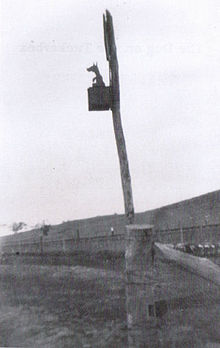This is an old revision of this page, as edited by 144.139.221.99 (talk) at 11:46, 5 March 2007. The present address (URL) is a permanent link to this revision, which may differ significantly from the current revision.
Revision as of 11:46, 5 March 2007 by 144.139.221.99 (talk)(diff) ← Previous revision | Latest revision (diff) | Newer revision → (diff)35°00′01.84″S 148°06′39.97″E / 35.0005111°S 148.1111028°E / -35.0005111; 148.1111028



The Dog on the Tuckerbox is an Australian historical monument and tourist attraction, located at Snake Gully, five miles (8 km) from Gundagai, New South Wales. It was sculpted by local stonemason Frank Rusconi and was unveiled by the then Prime Minister of Australia Joseph Lyons on 28 November, 1932 as a tribute to pioneers.
A dog monument had been first erected at a site nine miles from Gundagai in 1926.
The statue was inspired by a bullock driver's poem, Bullocky Bill, written by an otherwise unknown poet who used the pen name 'Bowyang Yorke' and first printed in 1857. A later poem by Jack Moses drew on the Bowyang Yorke poem for inspiration and was published in the 1920s. The latter poem was very popular and was the inspiration for the statue. Moses's poem, Nine Miles from Gundagai was first published in 1938, several years after the statue's unveiling. Jack O'Hagan's song, Where the Dog Sits on the Tuckerbox (5 miles from Gundagai) was published in 1937.
Frank Rusconi had suggested a memorial using the legend of the Dog on the Tuckerbox in 1928. However, in 1932 the proposal was taken up by the community. The Gundagai Independent of 11 August 1932 wrote:
"A Monument should be erected at the Nine Mile peg dedicated to the pioneers and bullockies, who made the highway of today possible. And there should be an unveiling ceremony during 'Back to Gundagai Week'."
However, the real story of the Dog on the Tuckerbox (DonT) is as follows:
Coolac or DonT Massacre
Gundagai is known for an image of a dog on a box. This symbolism is more recently based on a poem about a bullock waggon stuck in the mud near Gundagai pre gazettal of Gundagai as a town in 1838. This bullock waggon carried a load of flour for the European settlers. The flour had to come from the mill at Goulburn. There was a severe drought happening. The flour on the bogged bullock wagon was rifled while the bullock driver was in the nearby hotel and subsequently, the remaining flour was laced with arsenic. More flour was taken from the waggon by Aboriginal people with the end result being there were many deaths. The massacre was heard about in Sydney and was investigated, but no one was able to be held to account. For many years the event was told and retold and a dog figure, representing an aspect of Australian Aboriginal lore, was placed on a stick at the Nine Mile near where the massacre happened. A photo exists of this earlier Dog monument. The story was passed down among long-time Gundagai residents and is still spoken about in Gundagai today but for many years when it was mentioned, people were told not to speak about it. The story was also retold in a popular Australian poem by Jack Moses but from a different, perhaps less challenging, perspective which explained the lingering tale that just would not go away. The known disparity between, and debate about, whether the event happened at the Five Mile or Nine Mile is to do with this. The event is known as ‘The Coolac Massacre’.
The Dog on the Tuckerbox monument was erected as part of 'Back to Gundagai' Week in 1932 and a large crowd "gathered to her again" to witness the unveiling by the Prime Minister. It was planned to donate money placed in the wishing well at the base of the monument to the Gundagai District Hospital. A souvenir shop was also opened nearby.
The Back to Gundagai Committee had chosen the Five Mile camping site rather than the Nine Mile Peg as a location for the monument on the basis that it was more convenient to the Hume Highway and closer to the town, thereby more beneficial to tourism.
A nationwide competition was held to obtain the most suitable inscription for the monument. The chosen inscription on the base of the monument was written by Brian Fitzpatrick of Sydney. The inscription says:
- Earth's self upholds this monument
- To conquerors who won her,
- When wooing was dangerous
- And are now gathered unto her again."
An annual Dog on the Tuckerbox festival has been held each year since 1992, the 60th anniversary of the monument. In November 2005, the Annual Festival included a 2 day Snake Gully Cup Racing Carnival and festivities at the Dog on the Tuckerbox centre.
A food court style development opened nearby in 2006 with a KFC, Subway, McCafe, BP service station and Tuckerbox restaurant.
External link
- Dog on the Tuckerbox tribute page including the two poems that inspired the monument
References
- Scarff, L (1994). The Dog on the Tuckerbox: it's story. Kangaroo Press, Kenthurst, NSW. 0864176279
- Daniel, Frank. "History of the Dog on the Tuckerbox". Jack Moses poetry; Master poets. Bushpoetry.com.au. Retrieved 2006-11-17.
{{cite web}}: Cite has empty unknown parameter:|coauthors=(help) - ^ Butcher, C., (2002) Gundagai: A Track Winding Back, C. Butcher, publisher, pp 212-213.
- Butcher, page 228
- http://gundagai.local-e.nsw.gov.au/events/pages/1034.html